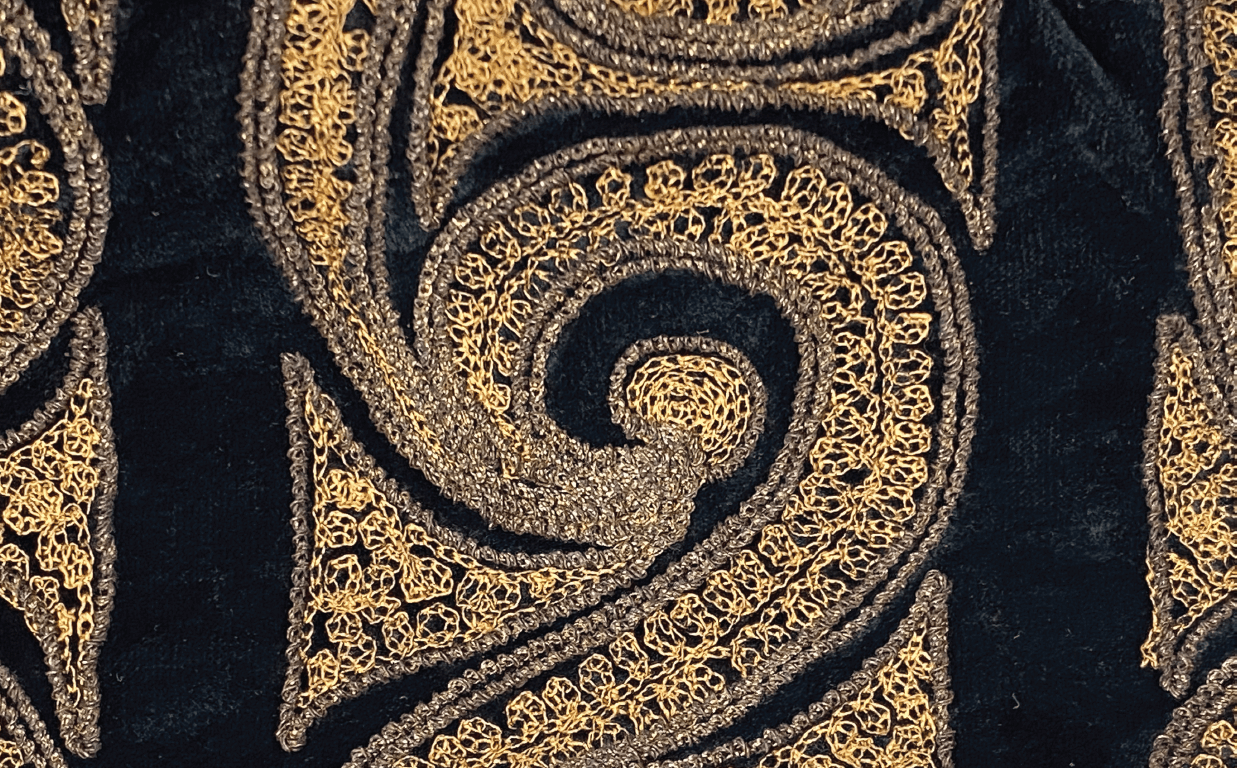Above: Detail from Archie Rand. 326: To Send the Impure from the Temple (Numbers 5:2), 2001-2006. From the series The 613. Acrylic on canvas. 20 x 16 in. Photo by Samantha Baskind
ARTIST–SCHOLAR COLLABORATIONS

Detail of Babani’s chain stitch method. Evening dress or tea gown, black velvet with metallic embroidery, ca. 1928. Museum at FIT P87.30.1, Museum Purchase. Photograph by Linsey Labson
When is fashion art? When is it Jewish? The work of the avant-garde fashion designer Vitali Babani (1858–1940) allows us to grapple with these questions while examining pieces that have never before been analyzed in a Jewish context.
Whether fashion qualifies as an art form has long preoccupied fashion historians, who have made the case for expanding our definition of art to include a broad range of objects, including textiles. Such pieces were the staple of the business that Vitali Babani built up in Paris during the Belle Époque and interwar period after moving to that city as a young man from his native Constantinople. The Maison Babani produced a range of styles and products over the years, including garments inspired by North African, Middle Eastern, South and East Asian designs, as well as the modernist Parisian milieu of his day. Signature features of Babani garments included their use of silk velvets with heavy metallic embroidery, created using a distinctive chain stitch method.
Babani dresses and coats featuring rich colors such as mustard, crimson, emerald green, dusty blue, and copper— as well as those cut from black fabric that amplifies the contrast with the gold thread embroidery—have featured in numerous exhibitions and are held in over a dozen museum collections around the world, including the Metropolitan Museum of Art in New York, the Victoria & Albert in London, and the Musée de la Mode de la Ville de Paris. Each is one of a kind, much like other forms of art, such as a painting or a sculpture.
But were they Jewish? Maison Babani’s designs make no explicit reference to Jewish material or traditions. Yet many of the designer’s avant-garde pieces drew inspiration from the material environment of the Ottoman capital where Vitali was raised and the clothing styles shared there by Jews and their non-Jewish neighbors. Embroidery with metallic thread on heavy velvets was a common feature of celebratory clothes among Ottoman Jews and Muslims alike. In this sense, the traditional garments Babani would have seen in his youth and which inspired much of his couture were Jewish, if not exclusively. Despite this, one searches in vain for any reference to Babani’s Jewishness— on museum websites, exhibition catalogues, and auction sites featuring Babani pieces. The Jewishness of the designer—and thus also of his designs—has disappeared from view, leaving us with only fragments of the larger story.

Dress, silk velvet with metallic embroidery, Babani, ca. 1926. Metropolitan Museum of Art 1995.506.1, Gift of Richard and Judith Webb
This elision was not accidental. It forms part of a broader pattern that Jews of Middle Eastern origin experienced throughout the modern period as they made their way to new shores. This was true for Ottoman Jews who immigrated to the Americas in the late nineteenth and early twentieth centuries only to find that many of their new neighbors did not believe them to be Jewish—whether because of their places of origin, the languages they spoke, or the way they looked and dressed. Aviva Ben-Ur has described the cool and sometimes incredulous responses Ottoman Sephardim received after announcing their Jewishness to Ashkenazic Jews in the early twentieth- century United States as “co-ethnic recognition failure.”i Registering a related pattern in Argentina during the same period, Adriana Brodsky has suggested that “Sephardim were invisible as Jews to Argentines” because “they were linguistically different from Ashkenazim, lived in different … neighborhoods, wore different styles of clothing, and had cultural and political practices … acquired in … lands … not associated with Jewishness in Argentina.”ii Ottoman Jews living in fin-de-siècle France recorded similar experiences, noting that even people they encountered on a daily basis did not recognize them as Jewish.iii Jews in such contexts appeared to others as “Turks,” “Arabs,” “Greeks,” or Mediterranean or “Hispanic” types, with little recognition that even when they were some, or all, of those things, they were also Jews.
So it was for Vitali Babani. Both during his lifetime and long after his death commentators have described him variously as French, Italian, Turkish, and “Middle Eastern,” but never as Jewish. Perhaps the rare scholars aware of the family’s Jewishness deemed it irrelevant to his artistic production and career. In other instances, it would seem, his Jewishness— like that of so many Middle Eastern Jews who made their homes in new émigré centers in the modern period— has simply gone undetected. Yet the techniques and materials his fashion house employed were not only broadly Ottoman but also intensely Jewish: many of the wedding dresses and synagogue adornments that Ottoman Jews made, used, reused, donated, and passed down within their families and communities bear a striking resemblance to the designs for which Maison Babani is best remembered today. Suggesting that various of Babani’s pieces were inspired by Middle Eastern design without also entertaining the possibility that they might—simultaneously— be Jewish runs the risk of reinforcing unnecessarily narrow ideas about what Jewishness is, or is not.
Bringing Babani designs into discussions of Jewish art is also useful for other reasons. Although the fashion house drew from the wellspring of historical Middle Eastern, North African, South and East Asian patterns and silhouettes, it was also decidedly modernist in its artistic orientation. As one of the earliest designers to introduce loose-fitting gowns into early twentieth-century Parisian fashion, Babani participated in the dress reform movement that helped free women from the confines of the corset and tightly tailored clothing. How often do histories of fashion or avant-garde art in this early twentieth-century moment recognize the role that Middle Eastern Jews played at the vanguard of both developments? The case of Babani invites us to reconsider our narratives once again.

JULIA PHILLIPS COHEN is associate professor in the Department of History and the Program in Jewish Studies at Vanderbilt University. She is the author of two books: Becoming Ottomans: Sephardi Jews and Imperial Citizenship in the Modern Era (New York: Oxford University Press, 2014), and—together with Sarah Abrevaya Stein—Sephardi Lives: A Documentary History, 1700–1950 (Stanford, CA: Stanford University Press, 2014). She is now preparing a modern history of Ottoman Jewish women’s work as well as a collaborative project with Devi Mays on the Babani fashion house.

LINSEY LABSON received her graduate degree from the Fashion Institute of Technology, where she studied fashion and textile history, with additional training in textile conservation. Her master’s thesis, “Babani: Life and Legacy of a Forgotten Designer, 1894 –1935,” (Fashion Institute of Technology, 2021), serves as a reference for scholars of fashion and textile studies, and provides a comprehensive overview of Babani garments and paper ephemera found in collections worldwide.

Devi Mays is associate professor of Judaic Studies and History at the University of Michigan, and the author of Forging Ties, Forging Passports: Migration and the Modern Sephardi Diaspora (Stanford, CA: Stanford University Press, 2020). She is currently working on a critical translation of the Izmir-based Ottoman Jewish journalist Alexandre Ben Ghiat’s Ladino diary of World War I—entitled Two Steps from the Abyss: An Ottoman Jewish Witness to War—as well as a collaborative project with Julia Phillips Cohen on the Babani fashion house.
iAviva Ben-Ur, Sephardic Jews in America: A Diasporic History (New York: New York University Press, 2009). On this phenomenon in the United States, see also Devin Naar, “Between ‘New Greece’ and the ‘New World’: Salonican Jews en route to New York,” Journal of the Hellenic Diaspora 35, no. 2 (Fall 2009): 45, 64–65; Jane Gerber, “Sephardic and Syrian Immigration to America: Acculturation and Communal Preservation,” in Contemporary Sephardic Identity in the Americas: An Interdisciplinary Approach, ed. Margalit Bejarano and Edna Aizenberg (Syracuse, NY: Syracuse University Press, 2012), 49–56; Julia Phillips Cohen and Sarah Abrevaya Stein, eds., Sephardi Lives: A Documentary History (Stanford, CA: Stanford University Press, 2014), 371–73.
iiAdriana M. Brodsky, Sephardi, Jew, Argentine: Community and National Identity (Bloomington: Indiana University Press, 2016), 2. See also Sandra McGee Deutsch, Crossing Borders, Claiming a Nation: A History of Argentine Jewish Women, 1880–1955 (Durham, NC: Duke University Press, 2010), 239, and, for elsewhere in Latin America, Margalit Bejarano, “From All Their Habitations: Sephardic Jews in Cuba,” Judaism 51, no. 1 (Winter 2002): 96–97; Devi Mays, Forging Ties, Forging Passports: Migration and the Modern Sephardi Diaspora (Stanford, CA: Stanford University Press, 2020), 163–64.
iiiCohen and Stein, Sephardi Lives, 200–206.